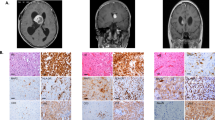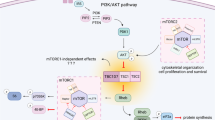Abstract
Tuberous sclerosis complex (TSC) is an autosomal dominant tumor predisposition syndrome characterized by benign proliferations (hamartomas). In the brain, individuals with TSC develop autism, mental retardation and seizures associated with focal cortical dysplasias, subependymal nodules, and subependymal giant cell astrocytomas (SEGAs). We hypothesize that dysregulated astrocyte function due to mutations in the tumor suppressor genes, TSC1 and TSC2, may contribute to the pathogenesis of these brain abnormalities. In this report, we demonstrate that mice heterozygous for a targeted defect in either the Tsc1 or Tsc2 genes(Tsc1+/− and Tsc2+/− mice) exhibit a 1.5-fold increase in the number of astrocytes in vivo. Whereas increased astrocyte numbers in vivo were suggestive of a proliferative advantage, Tsc2+/− primary astrocyte cultures did not show a cell-autonomous growth advantage, anchorage-independent growth, increased saturation density, or increased fluid-phase endocytosis compared to wild type astrocytes. Tsc2 null mouse embryonic fibroblasts (MEFs) however, did exhibit increased saturation density compared to Tsc2 wild type controls. In both Tsc2+/− astrocytes and Tsc2 null mouse embryonic fibroblasts, p27-Kip1 expression was decreased compared to wild type cells, and was reversed by tuberin re-expression in Tsc2−/− MEFs. In contrast, no change in endocytosis was observed upon tuberin re-expression in Tsc2−/− MEFs. Collectively, these results suggest Tsc heterozygosity may provide a non-cell-autonomous growth advantage for astrocytes that may involve p27-Kip1 expression.
This is a preview of subscription content, access via your institution
Access options
Subscribe to this journal
Receive 50 print issues and online access
$259.00 per year
only $5.18 per issue
Buy this article
- Purchase on Springer Link
- Instant access to full article PDF
Prices may be subject to local taxes which are calculated during checkout







Similar content being viewed by others
References
Altschuler DL, Ribeiro-Neto F . 1998 Proc. Natl. Acad. Sci. USA 95: 7475–7479
Bajenaru ML, Donahoe J, Corral T, Reilly KM, Brophy S, Pellicer A, Gutmann DH . 2001 Glia 33: 314–323
Crino PB, Henske EP . 1999 Neurology 53: 1384–1390
Donehower LA, Harvey M, Slagle BL, McArthur MJ, Montgomery Jr CA, Butel JS, Bradley A . 1992 Nature 356: 215–221
Eddleston M, Mucke L . 1993 Neuroscience 54: 15–36
Fero ML, Rivkin M, Tasch M, Porter P, Carow CE, Firpo E, Polyak K, Tsai LH, Broudy V, Perlmutter RM, Kaushansky K, Roberts JM . 1996 Cell 85: 733–744
Gao X, Pan D . 2001 Genes Dev. 15: 1383–1392
Gomez MR, Sampson JR, Whittemore VH . 1999 Tuberous sclerosis Third edition Oxford, UK: Oxford University Press
Green AJ, Smith M, Yates JRW . 1994 Nat. Genet. 6: 193–196
Gutmann DH, Hirbe AC, Haipek CA . 2001 Hum. Mol. Genet. 10: 1519–1529
Gutmann DH, Saporito-Irwin S, DeClue JE, Wienecke R, Guha A . 1997 Oncogene 15: 1611–1616
Gutmann DH, Loehr A, Zhang Y, Kim J, Henkemeyer M, Cashen A . 1999 Oncogene 18: 4450–4459
Gutmann DH, Zhang Y, Hasbani MJ, Goldberg MP, Plank TL, Henske EP . 2000 Acta Neuropathol. 99: 223–230
Hengst L, Dulic V, Slingerland JM, Lees E, Reed SI . 1994 Proc. Natl. Acad. Sci. USA 91: 5291–5295
Henske EP, Scheithauer BW, Short MP, Wollmann R, Nahmias J, Hornigold N, van Slegtenhorst M, Welsh CT, Kwiatkowski DJ . 1996 Am. J. Hum. Genet. 59: 400–406
Hewett SJ, Choi DW, Gutmann DH . 1995 NeuroReport 6: 1505–1508
Jin F, Wienecke R, Xiao G-H, Maize JC, DeClue JE, Yeung RS . 1996 Proc. Natl. Acad. Sci. USA 93: 9154–9159
Jacks T, Remington L, Williams BO, Schmitt EM, Halachmi S, Bronson RT, Weinberg RA . 1994 Curr. Biol. 4: 1–7
Kleymenova E, Ibraghimov-Beskrovnaya O, Kugoh H, Everitt J, Xu H, Kiguchi K, Landes G, Harris P, Walker C . 2001 Mol. Cell 7: 823–832
Lamb RF, Royt C, Diefenbach TJ, Vinters HVI, Johnson MW, Jay DG, Hall A . 2000 Nat. Cell Biol. 2: 281–287
Lantuejoul S, Ferretti G, Negoescu A, Parent B, Brambilla E . 1997 Histopathology 30: 570–575
Lendahl U, Zimmerman L, McKay R . 1990 Cell 60: 585–595
Maheshwar MM, Cheadle JP, Jones AC, Myring J, Fryer AE, Harris PC, Sampson JR . 1997 Hum. Mol. Genet. 6: 1991–1996
Miloloza A, Rosner M, Nellist M, Halley D, Bernaschek G, Hengtschlager M . 2000 Hum. Mol. Genet. 9: 1721–1727
Mouchel Y, Lefrancois T, Fages C, Tardy M . 1995 NeuroReport 7: 205–208
Nellist M, van Slegtenhorst MA, Goedbloed M, van den Ouweland AMW, Halley DJJ, van der Sluijs P . 1999 J. Biol. Chem. 274: 35647–35652
Niida Y, Stemmer-Rachamimov AO, Logrip M, Tapon D, Perez R, Kwiatkowski DJ, Sims K, MacCollin M, Louis DN, Ramesh V . 2001 Am. J. Hum. Genet. 69: 493–503
Onda H, Lueck A, Marks PW, Warren HB, Kriatkowski DJ . 1999 J. Clin. Invest. 104: 687–695
Parry L, Maynard JH, Patel A, Hodges AK, von Deimling A, Sampson JR, Cheadle JP . 2000 Hum. Genet. 107: 350–356
Plank TL, Yeung RS, Henske EP . 1998 Cancer Res. 58: 4766–4770
Potter CJ, Huang H, Xu T . 2001 Cell 105: 357–368
Povey S, Burley MW, Attwood J, Benham F, Hunt D, Jeremiah SJ, Franklin D, Gillett G, Malas S, Robson EB . 1994 Ann. Hum. Genet. 58: 107–127
Reilly KM, Loisel DA, Bronson RT, McLaughlin ME, Jacks T . 2000 Nat. Genet. 26: 109–113
Rizvi TA, Akunuru S, de Courten-Myers G, Switzer III RC, Nordlung ML, Ratner N . 1999 Brain Res. 816: 111–123
Roach ES, Gomez MR, Northrup H . 1998 J. Child Neurol. 13: 624–628
Soucek T, Yeung RS, Hengstschlager M . 1998 Proc. Natl. Acad. Sci. USA 95: 15653–15658
Stenmark H, Buccci C, Zerial M . 1995 Methods Enzymol. 257: 155–164
Tapon N, Ito N, Dickson BJ, Treisman JE, Hariharan IK . 2001 Cell 105: 345–355
The European Chromosome 16 Tuberous Sclerosis Consortium. 1993 Cell 75: 1305–1315
van Slegtenhorst M, de Hoogt R, Hermans C, Nellist M, Janssen B, Verhoef S, Lindhout D, Burley M, Jeremiah S, Woodward K, Nahmias J, Fox M, Ekong R, Osborne J, Wolfe J, Povey S, Snell RG, Cheadle JP, Jones AC, Tachataki M, Ravine D, Sampson JR, Reeve MP, Richardson P, Wilmer F, Munro C, Hawkins TL, Sepp T, Ali JBM, Ward S, Green AJ, Yates JRW, Kwiatkowska J, Henske EP, Short MP, Haines JH, Sergiuisz J, Kwiatkowski DJ . 1997 Science 277: 805–808
van Slegtenhorst M, Nellist M, Nagelkerken B, Cheadle J, Snell R, van den Ouweland A, Reuser A, Sampson J, Halley D, van der Sluijs P . 1998 Hum. Mol. Genet. 7: 1053–1057
van Slegtenhorst M, Verhoef S, Tempelaars A, Bakker L, Wang Q, Wessels M, Bakker R, Nellist M, Lindhout D, Halley D, van den Ouweland A . 1999 J. Med. Genet. 36: 285–289
Wienecke R, Konig A, DeClue JE . 1995 J. Biol. Chem. 270: 16409–16414
Wienecke R, Guha A, Maize JC, Heideman RL, DeClue JE, Gutmann DH . 1997 Ann. Neurol. 42: 230–235
Wolf HK, Normann S, Green AJ, von Bakel I, Blumcke I, Pietsch T, Wiestler OD, von Deimling A . 1997 Acta Neuropathol. 93: 93–96
Xiao G-H, Shoranijad F-J, Golemis EA, Yeung RS . 1997 J. Biol. Chem. 272: 6097–6100
Acknowledgements
We appreciate the helpful discussions and suggestions provided by Drs Gerry Boss, Peter Crino and Philip Stahl during the execution of these experiments. This work was supported by generous funding from the Tuberous Sclerosis Alliance Center without Walls initiative (to DH Gutmann and D Kwiatkowski) and NIH grant NS31535 (to D Kwiatkowski). ML Bajenaru was supported by a fellowship from the National Tuberous Sclerosis Association.
Author information
Authors and Affiliations
Corresponding author
Rights and permissions
About this article
Cite this article
Uhlmann, E., Apicelli, A., Baldwin, R. et al. Heterozygosity for the tuberous sclerosis complex (TSC) gene products results in increased astrocyte numbers and decreased p27-Kip1 expression in TSC2+/− cells. Oncogene 21, 4050–4059 (2002). https://doi.org/10.1038/sj.onc.1205435
Received:
Revised:
Accepted:
Published:
Issue Date:
DOI: https://doi.org/10.1038/sj.onc.1205435
Keywords
This article is cited by
-
Tsc2 mutation rather than Tsc1 mutation dominantly causes a social deficit in a mouse model of tuberous sclerosis complex
Human Genomics (2023)
-
Notch transactivates Rheb to maintain the multipotency of TSC-null cells
Nature Communications (2017)
-
Inhibition of ERK1/2 Restores GSK3β Activity and Protein Synthesis Levels in a Model of Tuberous Sclerosis
Scientific Reports (2017)
-
The genomic landscape of tuberous sclerosis complex
Nature Communications (2017)
-
Altered glial marker expression in autistic post-mortem prefrontal cortex and cerebellum
Molecular Autism (2014)



